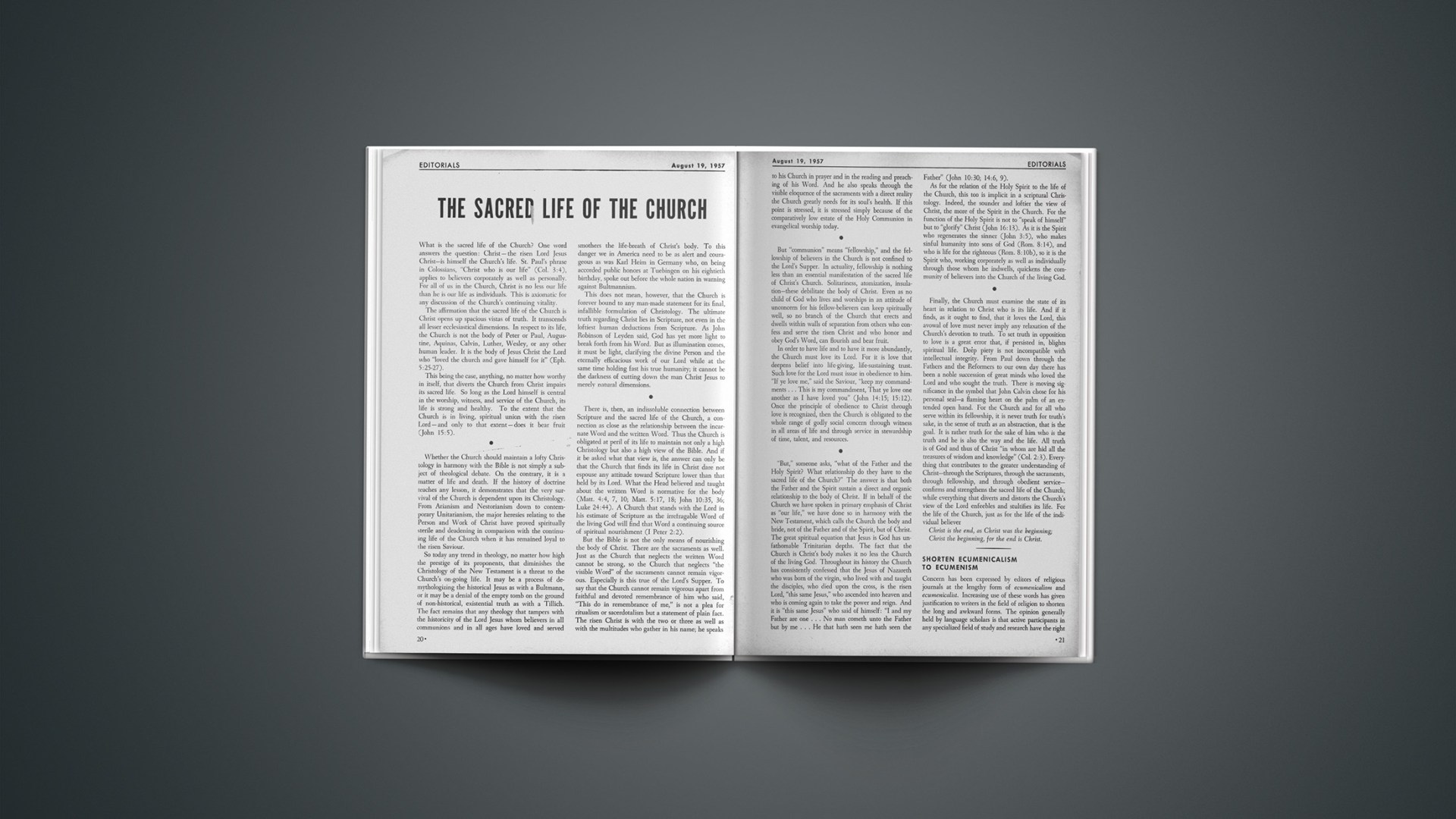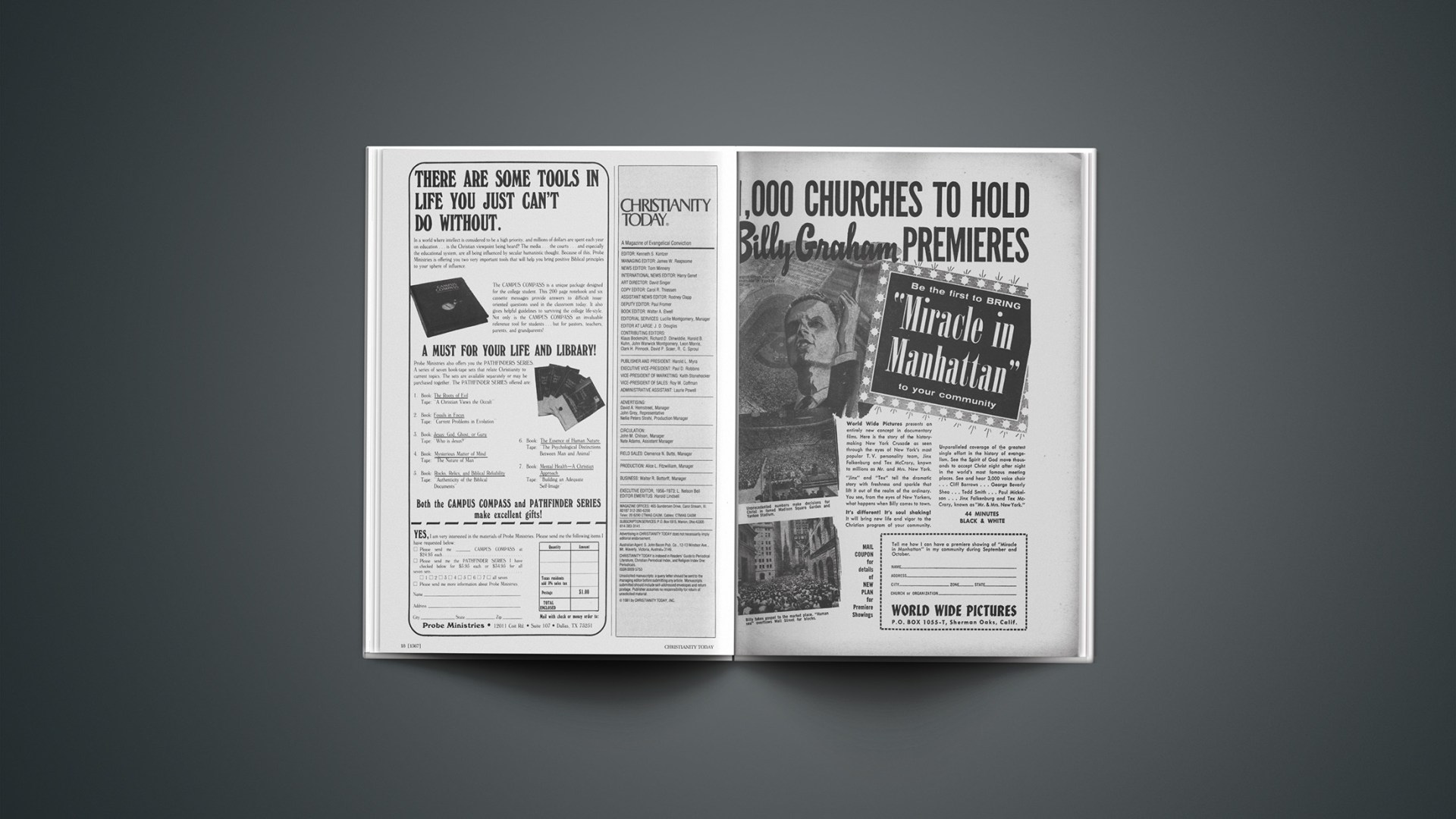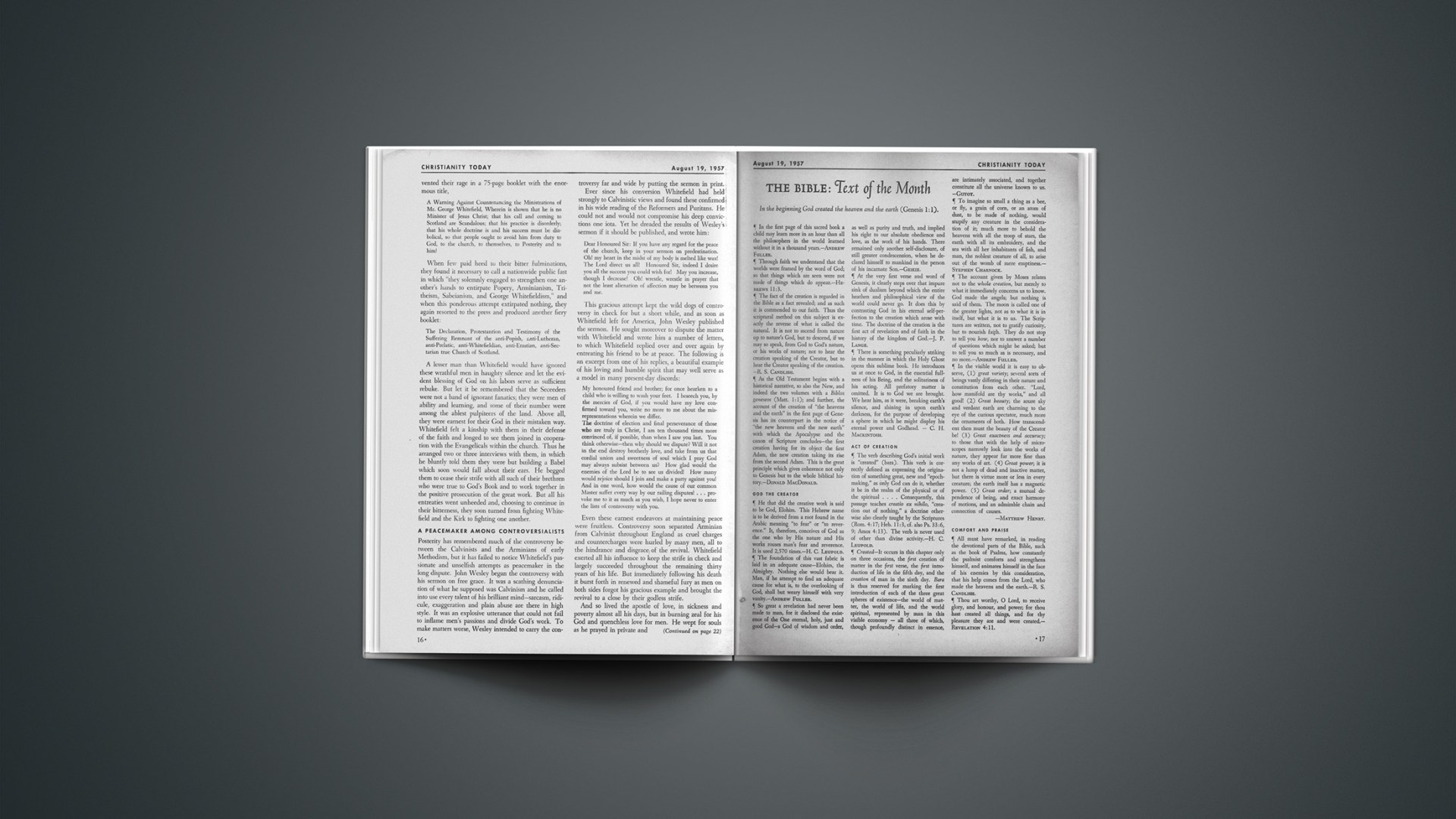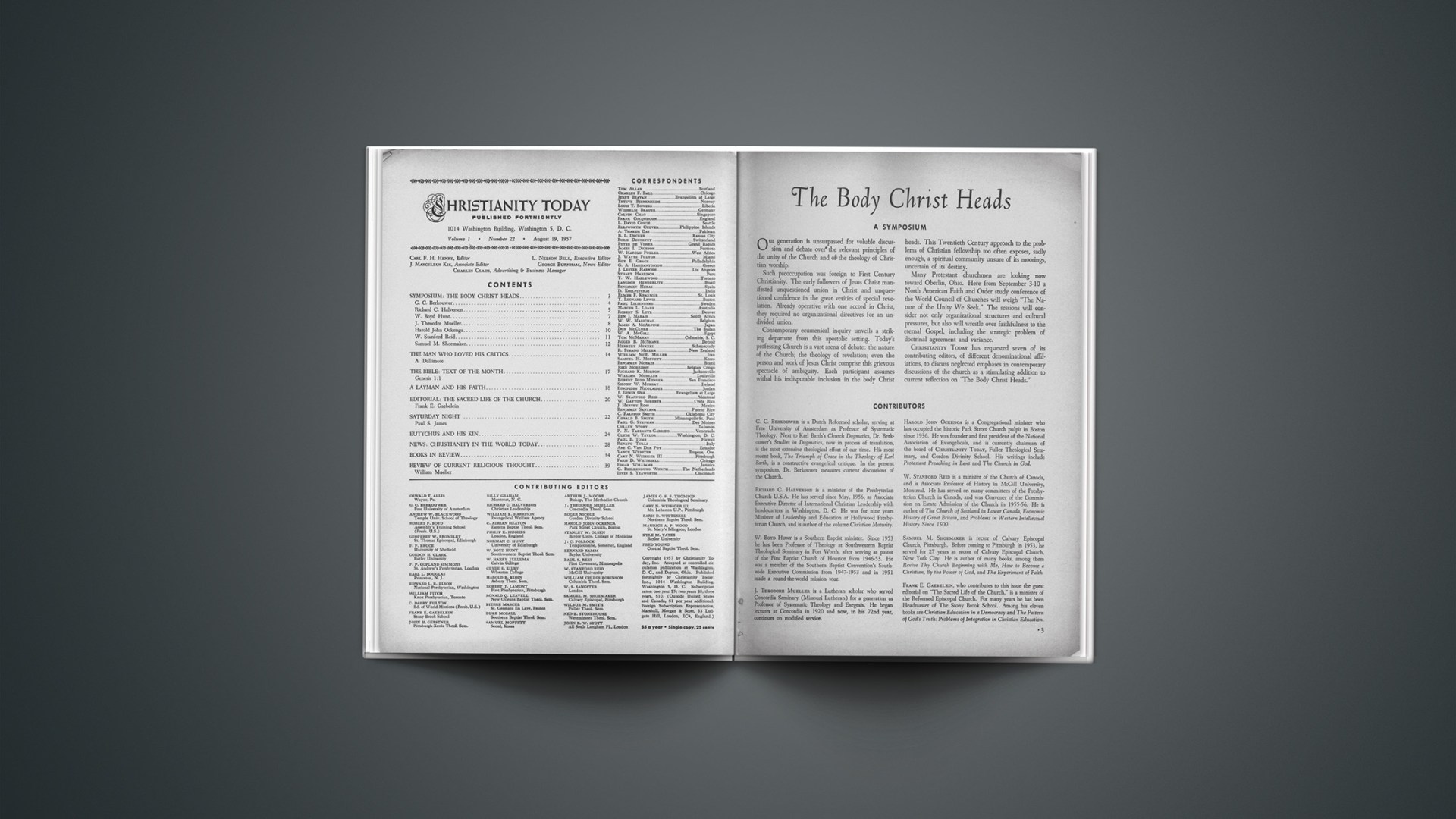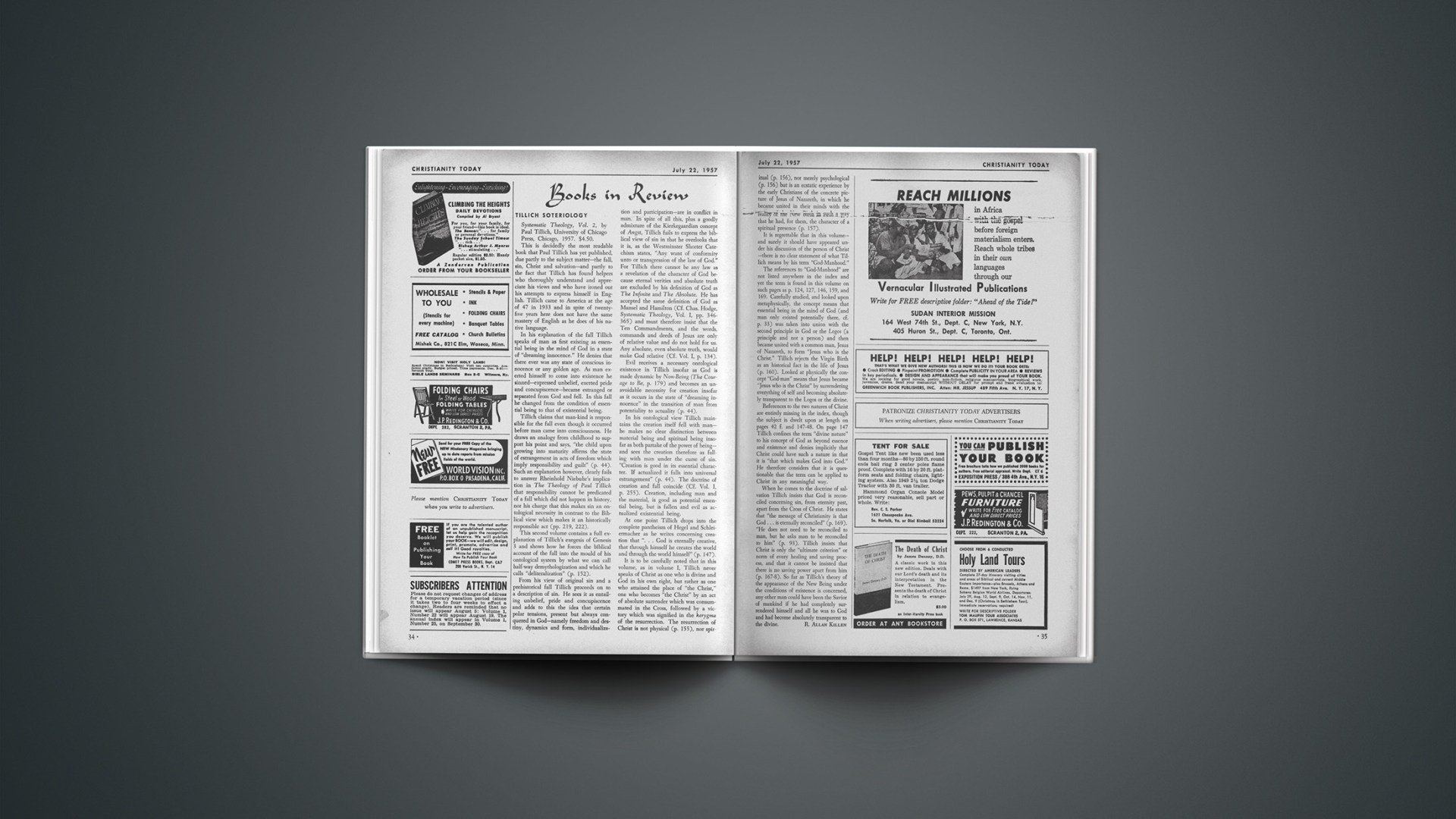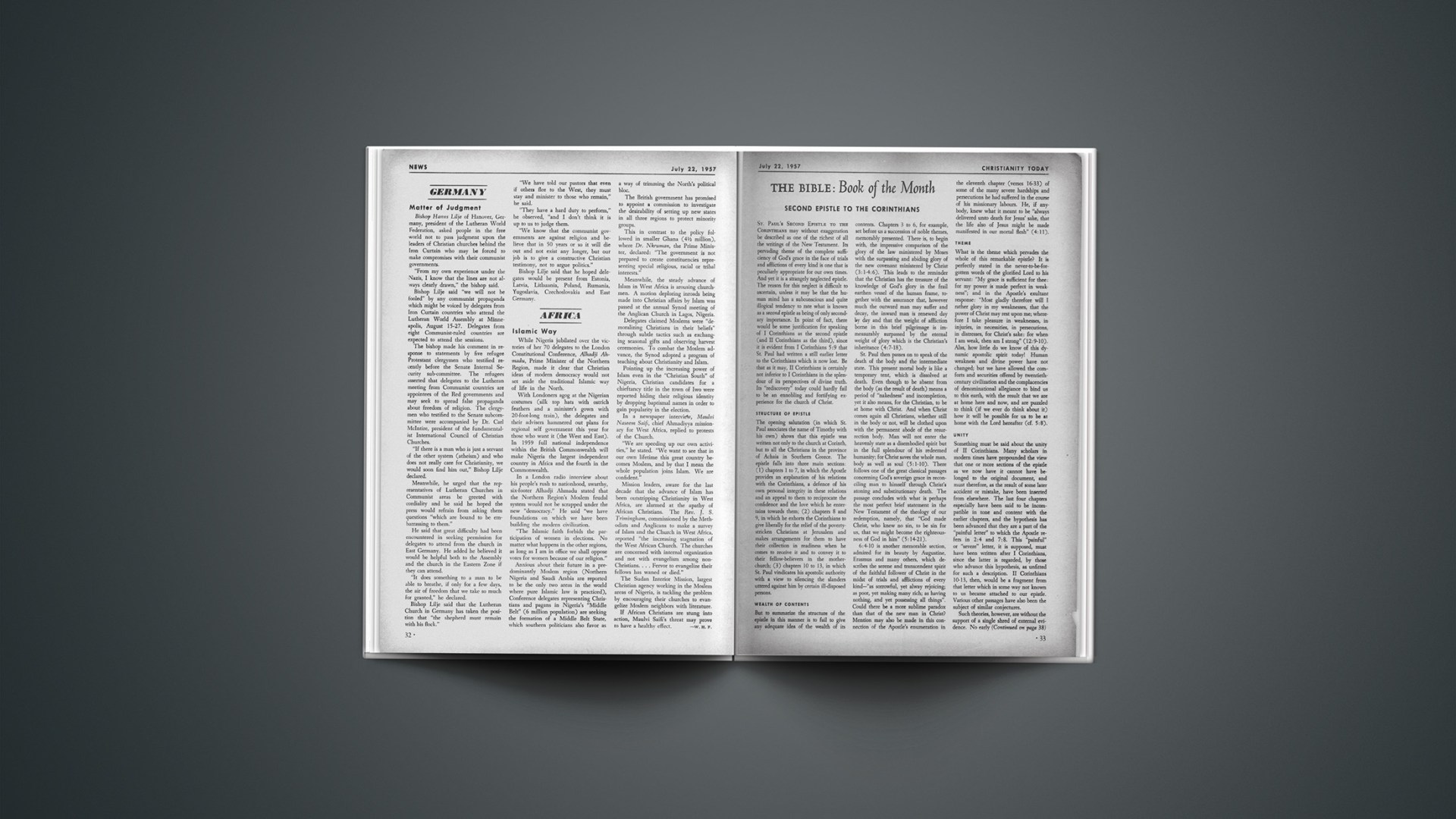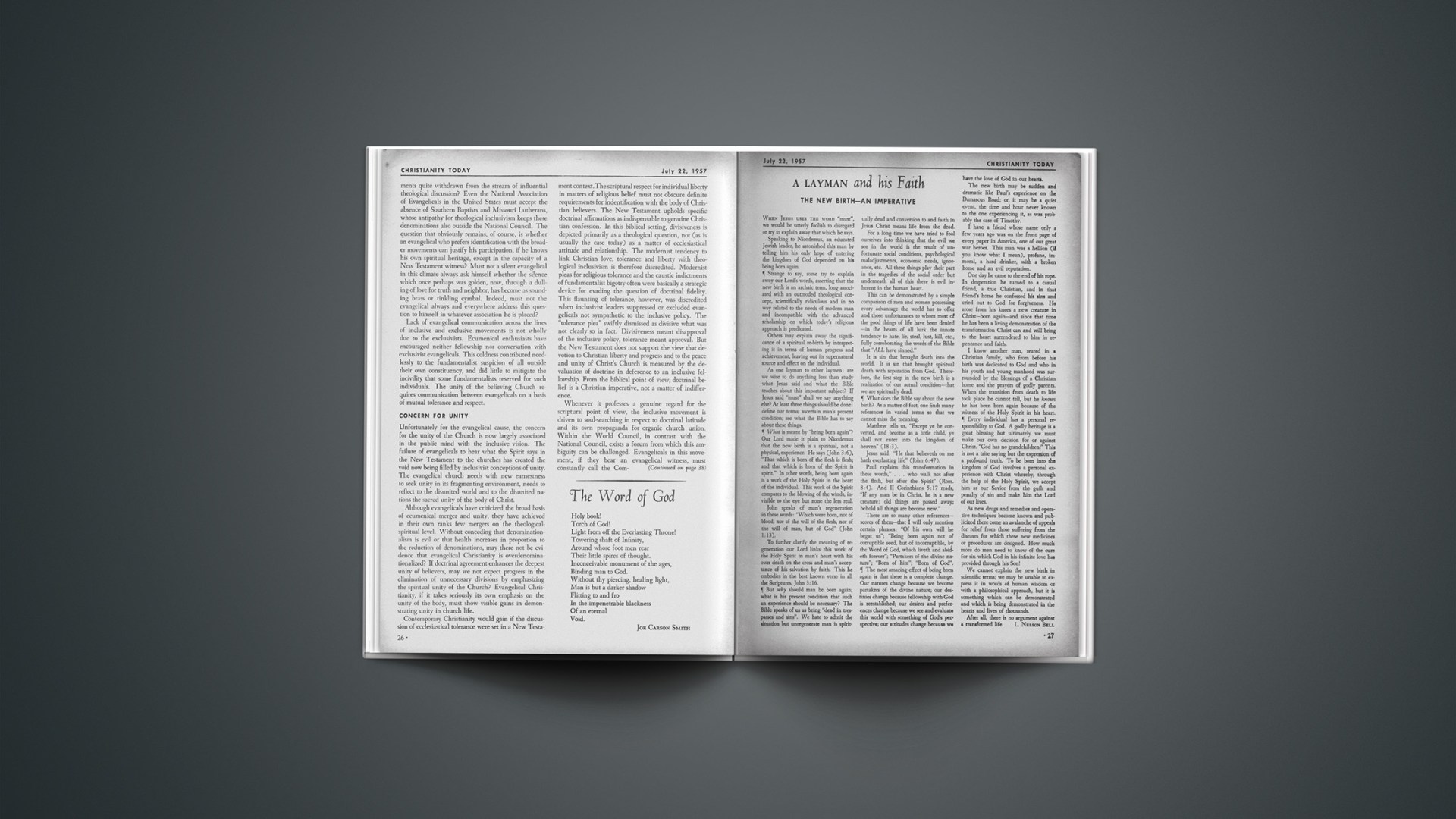What is the sacred life of the Church? One word answers the question: Christ—the risen Lord Jesus Christ—is himself the Church’s life. St. Paul’s phrase in Colossians, “Christ who is our life” (Col. 3:4), applies to believers corporately as well as personally. For all of us in the Church, Christ is no less our life than he is our life as individuals. This is axiomatic for any discussion of the Church’s continuing vitality.
The affirmation that the sacred life of the Church is Christ opens up spacious vistas of truth. It transcends all lesser ecclesiastical dimensions. In respect to its life, the Church is not the body of Peter or Paul, Augustine, Aquinas, Calvin, Luther, Wesley, or any other human leader. It is the body of Jesus Christ the Lord who “loved the church and gave himself for it” (Eph. 5:25–27).
This being the case, anything, no matter how worthy in itself, that diverts the Church from Christ impairs its sacred life. So long as the Lord himself is central in the worship, witness, and service of the Church, its life is strong and healthy. To the extent that the Church is in living, spiritual union with the risen Lord—and only to that extent—does it bear fruit (John 15:5).
Whether the Church should maintain a lofty Christology in harmony with the Bible is not simply a subject of theological debate. On the contrary, it is a matter of life and death. If the history of doctrine teaches any lesson, it demonstrates that the very survival of the Church is dependent upon its Christology. From Arianism and Nestorianism down to contemporary Unitarianism, the major heresies relating to the Person and Work of Christ have proved spiritually sterile and deadening in comparison with the continuing life of the Church when it has remained loyal to the risen Saviour.
So today any trend in theology, no matter how high the prestige of its proponents, that diminishes the Christology of the New Testament is a threat to the Church’s on-going life. It may be a process of demythologizing the historical Jesus as with a Bultmann, or it may be a denial of the empty tomb on the ground of non-historical, existential truth as with a Tillich. The fact remains that any theology that tampers with the historicity of the Lord Jesus whom believers in all communions and in all ages have loved and served smothers the life-breath of Christ’s body. To this danger we in America need to be as alert and courageous as was Karl Heim in Germany who, on being accorded public honors at Tuebingen on his eightieth birthday, spoke out before the whole nation in warning against Bultmannism.
This does not mean, however, that the Church is forever bound to any man-made statement for its final, infallible formulation of Christology. The ultimate truth regarding Christ lies in Scripture, not even in the loftiest human deductions from Scripture. As John Robinson of Leyden said, God has yet more light to break forth from his Word. But as illumination comes, it must be light, clarifying the divine Person and the eternally efficacious work of our Lord while at the same time holding fast his true humanity; it cannot be the darkness of cutting down the man Christ Jesus to merely natural dimensions.
There is, then, an indissoluble connection between Scripture and the sacred life of the Church, a connection as close as the relationship between the incarnate Word and the written Word. Thus the Church is obligated at peril of its life to maintain not only a high Christology but also a high view of the Bible. And if it be asked what that view is, the answer can only be that the Church that finds its life in Christ dare not espouse any attitude toward Scripture lower than that held by its Lord. What the Head believed and taught about the written Word is normative for the body (Matt. 4:4, 7, 10; Matt. 5:17, 18; John 10:35, 36; Luke 24:44). A Church that stands with the Lord in his estimate of Scripture as the irrefragable Word of the living God will find that Word a continuing source of spiritual nourishment (1 Peter 2:2).
But the Bible is not the only means of nourishing the body of Christ. There are the sacraments as well. Just as the Church that neglects the written Word cannot be strong, so the Church that neglects “the visible Word” of the sacraments cannot remain vigorous. Especially is this true of the Lord’s Supper. To say that the Church cannot remain vigorous apart from faithful and devoted remembrance of him who said, “This do in remembrance of me,” is not a plea for ritualism or sacerdotalism but a statement of plain fact. The risen Christ is with the two or three as well as with the multitudes who gather in his name; he speaks to his Church in prayer and in the reading and preaching of his Word. And he also speaks through the visible eloquence of the sacraments with a direct reality the Church greatly needs for its soul’s health. If this point is stressed, it is stressed simply because of the comparatively low estate of the Holy Communion in evangelical worship today.
But “communion” means “fellowship,” and the fellowship of believers in the Church is not confined to the Lord’s Supper. In actuality, fellowship is nothing less than an essential manifestation of the sacred life of Christ’s Church. Solitariness, atomization, insulation—these debilitate the body of Christ. Even as no child of God who lives and worships in an attitude of unconcern for his fellow-believers can keep spiritually well, so no branch of the Church that erects and dwells within walls of separation from others who confess and serve the risen Christ and who honor and obey God’s Word, can flourish and bear fruit.
In order to have life and to have it more abundantly, the Church must love its Lord. For it is love that deepens belief into life-giving, life-sustaining trust. Such love for the Lord must issue in obedience to him. “If ye love me,” said the Saviour, “keep my commandments … This is my commandment, That ye love one another as I have loved you” (John 14:15; 15:12). Once the principle of obedience to Christ through love is recognized, then the Church is obligated to the whole range of godly social concern through witness in all areas of life and through service in stewardship of time, talent, and resources.
“But,” someone asks, “what of the Father and the Holy Spirit? What relationship do they have to the sacred life of the Church?” The answer is that both the Father and the Spirit sustain a direct and organic relationship to the body of Christ. If in behalf of the Church we have spoken in primary emphasis of Christ as “our life,” we have done so in harmony with the New Testament, which calls the Church the body and bride, not of the Father and of the Spirit, but of Christ. The great spiritual equation that Jesus is God has unfathomable Trinitarian depths. The fact that the Church is Christ’s body makes it no less the Church of the living God. Throughout its history the Church has consistently confessed that the Jesus of Nazareth who was born of the virgin, who lived with and taught the disciples, who died upon the cross, is the risen Lord, “this same Jesus,” who ascended into heaven and who is coming again to take the power and reign. And it is “this same Jesus” who said of himself: “I and my Father are one … No man cometh unto the Father but by me … He that hath seen me hath seen the Father” (John 10:30; 14:6, 9).
As for the relation of the Holy Spirit to the life of the Church, this too is implicit in a scriptural Christology. Indeed, the sounder and loftier the view of Christ, the more of the Spirit in the Church. For the function of the Holy Spirit is not to “speak of himself” but to “glorify” Christ (John 16:13). As it is the Spirit who regenerates the sinner (John 3:5), who makes sinful humanity into sons of God (Rom. 8:14), and who is life for the righteous (Rom. 8:10b), so it is the Spirit who, working corporately as well as individually through those whom he indwells, quickens the community of believers into the Church of the living God.
Finally, the Church must examine the state of its heart in relation to Christ who is its life. And if it finds, as it ought to find, that it loves the Lord, this avowal of love must never imply any relaxation of the Church’s devotion to truth. To set truth in opposition to love is a great error that, if persisted in, blights spiritual life. Deep piety is not incompatible with intellectual integrity. From Paul down through the Fathers and the Reformers to our own day there has been a noble succession of great minds who loved the Lord and who sought the truth. There is moving significance in the symbol that John Calvin chose for his personal seal—a flaming heart on the palm of an extended open hand. For the Church and for all who serve within its fellowship, it is never truth for truth’s sake, in the sense of truth as an abstraction, that is the goal. It is rather truth for the sake of him who is the truth and he is also the way and the life. All truth is of God and thus of Christ “in whom are hid all the treasures of wisdom and knowledge” (Col. 2:3). Everything that contributes to the greater understanding of Christ—through the Scriptures, through the sacraments, through fellowship, and through obedient service—confirms and strengthens the sacred life of the Church; while everything that diverts and distorts the Church’s view of the Lord enfeebles and stultifies its life. For the life of the Church, just as for the life of the individual believer
Christ is the end, as Christ was the beginning;
Christ the beginning, for the end is Christ.
Shorten Ecumenicalism To Ecumenism
Concern has been expressed by editors of religious journals at the lengthy form of ecumenicalism and ecumenicalist. Increasing use of these words has given justification to writers in the field of religion to shorten the long and awkward forms. The opinion generally held by language scholars is that active participants in any specialized field of study and research have the right to determine their own technical vocabulary. For example, botanists now commonly use “monocot” for “monocotyledon,” geneticists use “allele” for “allelomorph,” and economists are increasingly using “camerist” instead of “cameralist.”
Several shortened forms of ecumenicalist are already in use—ecumenicist and ecumenist. The first is more in agreement with the classical Greek root and preferred by the language purist; the second finds more frequent use and is becoming increasingly popular. Objection has been voiced against the use of the shortened forms because they have been used by critics of ecumenicalists as terms of disparagement. However, the context rather than the form will determine the meaning. As the shortened form becomes more popular it will be used by both friend and foe.
If the term ecumenist finds general acceptance, no reason exists why ecumenicalism cannot be shortened to ecumenism. Language purists would prefer ecumenicism to conform to the classical Greek root. The shortest form, ecumenism, would find ready acceptance especially among laymen who find the pronunciation of ecumenicalism rather difficult.
Since the terms are used with greater frequency, CHRISTIANITY TODAY suggests the usage of the shortened forms, ecumenism and ecumenist. No semantic or logical reason prevents the employment of such abbreviations and many would welcome the change suggested.
END

